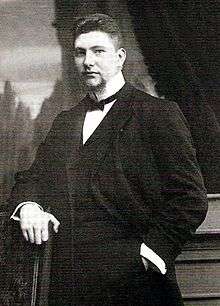Agustín Goovaerts
| Agustín Goovaerts | |
|---|---|
 | |
| Born |
1885 |
| Died |
August 15, 1939 Brussels |
| Alma mater | Catholic University of Louvain |
| Occupation | Architect |
| Buildings | Rafael Uribe Uribe Palace of Culture[1] |
Agustín Goovaerts was a Belgian architect and engineer, born in Schaerbeek, Brussels in 1885. Throughout his life, he designed a number of important urban architectural buildings, mainly in the Colombia, where he worked as the department of Antioquia's official architect during the 1920s.[2][3] Some of his works have been declared National Monuments in Colombia. He died at the age of 58 in Brussels due to leukemia caused by typhoid.
Biography
Agustín Goovaerts was born in Schaerbeek (Brussels) in 1885. He was the son of Celina and Alfonso Van Engelgeny (1847-1922), a leading intellectual in the European academic circles, as a librarian in Antwerp and later as a senior archivist of the Kingdom of Belgium. His father was also a polyglot, historian, musicologist, genealogist, editor.
From very young, Agustín Goovaerts began studying drawing at the Academy of Arts in Brussels, which he later completed in addition to architecture and engineering at the University of Leuven. Mandatory practices for students at Belgian universities allowed him to have direct contact with the work of Victor Horta, who was commissioned, the old Abbey of La Cambre, and the Dutchman Hendrik Berlage. He took up residence in Etterbeek, Brussels neighborhood where he began his architectural production, such as: the family home of Goovaerts, completed in 1907, and residences for families Desmet-Sillis and Desvaux-Berleur. He worked for a time in the office of the architect Edmond Serneels (1875-1934), who influenced the work of Goovaerts. There, he was responsible for the construction of the Church of Saint-Antoine, in Etterbeek, completed in 1910.
In 1914, he volunteered as a soldier at the beginning of the First World War. He was discharged from military service because of wounds suffered in combat. However, he continued as an active military organizer of a bilingual education network in Calais, the Belgian military barracks on the border with France. Before that, Goovaerts had taught drawing at the Belgian Military Institute of Vocational Rehabilitation. He served military service until 1918.
The initial period of his work in Medellin time between 1921 and 1924. During this period he created his largest projects, almost none of which is preserved, such as the Junín Theater, Cellular Jail La Ladera, and Ismael Correa Calpe, which hosted the mayor of Medellin in the twenties.
Style
When Goovaerts arrived in Colombia, he came with a lot of knowledge to implement. There was division between two stylistic tendencies: a very traditional, orthodox and academic type and an oriented position with the avant-garde, especially the art nouveau and modernism. The first was reflected more in public buildings and the second in his work for individuals.
Goovaerts was involved in the design and construction of more than 40 religious buildings.
Selected works
- National Palace, Colombia (1925)[4]
- Rafael Uribe Uribe Palace of Culture, Colombia (1920-1930)
- Church of the Sacred Heart of Jesus, Colombia (1924-1939)
- College of Medicine, University of Antioquia[2]
- Church of San José of El Poblado (1926)
- Monument in the San Pedro Cemetery Museum for Camilo Restrepo (1926)
- Chapel for the San Pedro Cemetery Museum (1925)
Gallery
| Wikimedia Commons has media related to Agustín Goovaerts. |
-
Church of Our Lady of Dolores, Colombia
-
National Palace of Medellín
-

Church of the Sacred Heart of Jesus, Colombia
References
- ↑ Michelin (1 March 2011). Colombia Green Guide Michelin 2012-2013. MICHELIN. p. 286. ISBN 978-2-06-718208-0.
- 1 2 Mercedes Lucia Vélez White (2003). Arquitectura contemporánea en Medellín. ITM. p. 7. ISBN 978-958-97283-4-5.
- ↑ Luis Fernando Molina (1 January 1998). Agustín Goovaerts y la Arquitectura Colombiana en Los Años Vientes. Banco de la República, El Áncora Editores. ISBN 978-958-96201-7-5.
- ↑ Jaime Osorio Gómez (2008). Patrimonio arquitectónico del valle del Aburrá: final del siglo xix y principio del siglo xx. ITM. p. 52. ISBN 978-958-8351-59-9.
Sources
- Velez White, Mercedes Lucia (1994). Agustín Goovaerts y la Arquitectura en Medellín. Editorial El Propio Bolsillo, Medellín.
- Molina Londoño, Luis Fernando (1998). Agustin Goovaerts y la arquitectura colombiana en los años veintes. El Áncora Editores -Banco de la República de Colombia, Bogotá.